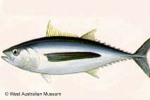Cook Islands Biodiversity Database
Species Page
Thunnus alalunga
To‘evereAlbacore Tuna
Multimedia & Additional Resources
| Type | Description | Download |
| Adult | 11KB | |
| Compare: Albacore and Yellowfin | 79KB |
General Information
Cook Islands Distribution
| Southern Group: Present Makatea: | ||||||||
RR |
MG |
AT |
MK |
MT |
AK |
PL |
TK |
MN |
P |
P |
|||||||
| Northern Group: | |||||
TN |
MH |
RK |
PK |
NS |
SW |
P |
|||||
Scientific Taxonomy
Thunnus alalunga (Bonnaterre, 1788)
SYNONYMS: Germo alalunga; Scomber alalunga [O]; Thunnus alalonga[misspelling]; Thunnus germo
TAXONOMY: ANIMALIA; CHORDATA; GNATHOSTOMATA (Jawed Vertebrates); PISCES; OSTEICHTHYES; Perciformes; Scombroidei; SCOMBRIDAE, Thunnini
More Information
SIGNIFICANCE NOTES -
POSITIVE SIGNIFICANCE: The main tuna of the Cook Islands longline fishery.. Comments: During 1995 two longliner boats harvested 137 mt in the Southern Group: 21% albacore, 10% bigeye, 14% yellowfin, 22% marlin, 20% swordfish, 6% Mahimahi, 1% Wahoo and 1% Spearfish (data MMR 2000). In 2003 this species was 60-70% of total Cook Islands longline catch (CINews 9/Aug/03).
NEGATIVE SIGNIFICANCE: Poisonous if stored poorly
GENERAL NOTE: Relatively slow growing, reaching breeding maturity at 4-5 years when about 90cm; and can grow to 120cm. Juvenile fish of about 2 years old are typically caught around Sub-Tropical Convergence Zone (STCZ) at around 40degS. They seem to make seasonal migrations into the tropics and spawn between 10-25deg.S.
They also migrate vertically, from surface to 400m depending on thermocline and oxygen concentration. Smaller surface fishes (50-80cm FL) by pole-and-line, purse-seining and trolling; larger fishes (90-120cm) by longline. The tropical South Pacific fishery is mainly August to February. (Josh Mitchell, CINew 9/Aug/03)
Vouchers & References
Vouchers:
Palmerston: Listed (Preston95). Pukapuka: fieldspecimen+photo, 3/2004, K.Salisbury with ID as Thunnus alalunga.
References:
Special Reference: Collette, B.B. & C.E. Nauen, FAO species catalogue. Vol. 2. Scombrids of the world. An annotated and illustrated catalogue of tunas, mackerels, bonitos and related species known to date. FAO Fish. Synop. (125)Vol.2:81.
p.445 Randall et al. (1990) Fishes of the Great Barrier Reef....
p.602 Burgess et al. (1988) Atlas of Marine Aquarium Fishes (TFH)
plate 96-07 Allen (1997) Marine Fishes of Tropical Australia....
Species No. 342 Munro (1967) Fishes of New Guinea
Data Update History (information):
zTX, zB02, zM02, zD02
Web Resources
Citation Information
McCormack, Gerald (2007) Cook Islands Biodiversity Database, Version 2007.2. Cook Islands Natural Heritage Trust, Rarotonga. Online at http://cookislands.bishopmuseum.org. ![]()
Please refer to our use policy.

